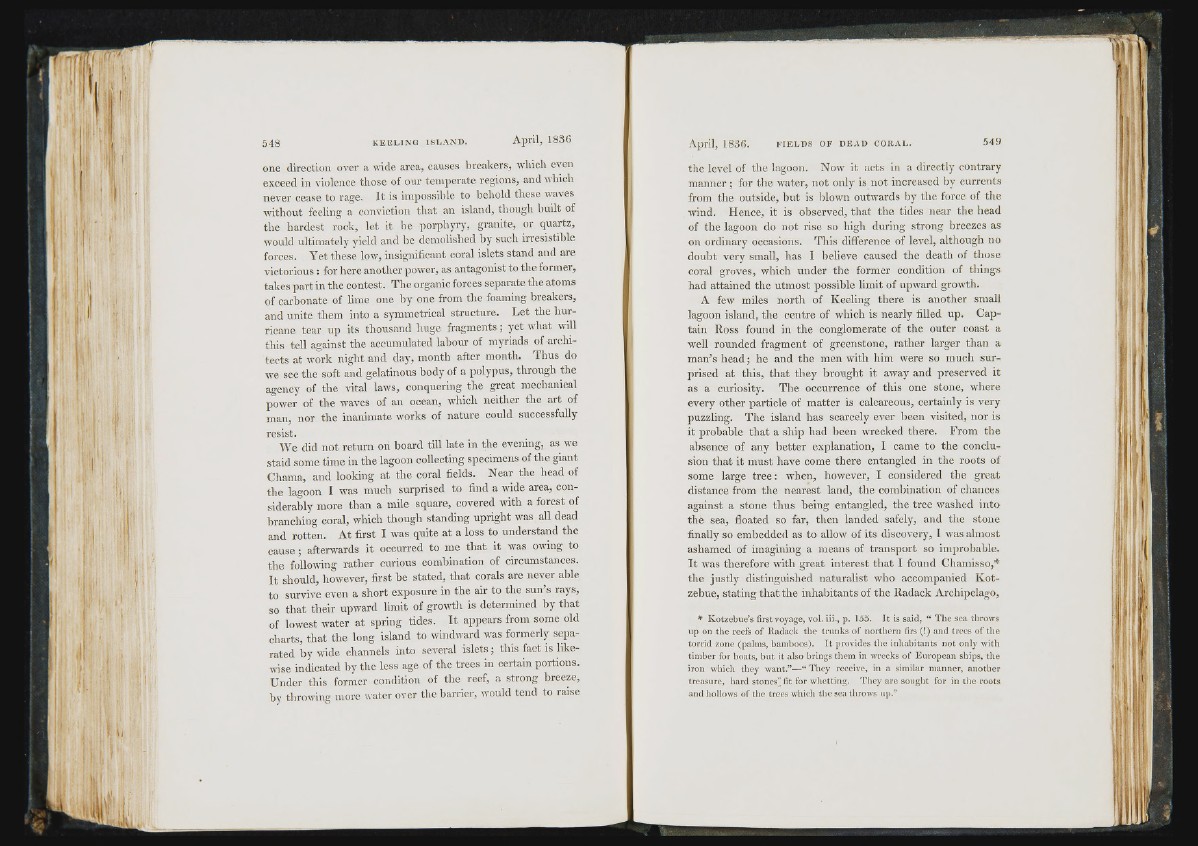
! L
Ili!
'■ riÍN‘
KE E L ING I S L A N D . April, 1836
one direction over a wide area, causes breakers, wliich even
exceed in violence those of our temperate regions, and which
never cease to rage. It is impossible to behold these waves
without feeling a conviction that an island, though built of
the hardest rock, let it be porphyry, granite, or quartz,
would ultimately yield and be demolished by such irresistible
forces. A’et these low, insignificant coral islets stand aud are
victorious : for here another power, as antagonist to the former,
takes part in the contest. The organic forces separate the atoms
of carbonate of lime one by one from the foaming breakers,
and unite them into a symmetrical structure. Let the hurricane
tear up its thousand huge fragments ; yet what will
this tell against the accumulated labour of myriads of architects
at work night and day, month after month. Thus do
we see the soft and gelatinous body of a polypus, through the
agency of the vital laws, conquering the great mechanical
power of the waves of an ocean, which neither the art of
man, nor the inanimate works of nature could successfully
resist.
We did not return on hoard till late in the evening, as we
staid some time in the lagoon collecting specimens of the giant
Chama, and looking at the coral fields. Near the head of
the lagoon I was much surprised to find a wide area, considerably
more than a mile square, covered with a forest of
branching coral, which though standing upright was all dead
and rotten. At first I was quite at a loss to understand the
cause ; afterwards it occurred to me that it was owing to
the following rather curious combination of circumstances.
It should, however, first be stated, that corals are never able
to .survive even a short exposure in the air to the sun’s rays,
so that their upward limit of growth is determined by that
of lowest water at spring tides. It appears from some old
charts, that the long island to windward was formerly separated
by wide channels into several islets ; this fact is likewise
indicated by the less age of the trees in certain portions.
Under this former condition of the reef, a strong breeze,
bv throwing more water over the barrier, would tend to raise
the level of the lagoon. Now it acts in a directly contrary
manner; for the water, not only is not increased by currents
from the outside, but is blown outwards by the force of the
wind. Hence, it is observed, that the tides near the head
of the lagoon do not rise so high during strong breezes as
on ordinary occasions. This difference of level, altliough no
doubt very small, has I believe caused the death of those
coral groves, which under the former condition of things
had attained the utmost possible limit of upward growth.
A few miles north of Keeling there is another small
lagoon island, the centre of which is nearly filled up. Captain
Ross found in the conglomerate of the outer coast a
well rounded fragment of greenstone, rather larger than a
man’s head; he and the men with him were so much surprised
at this, that they brought it away and preserved it
as a curiosity. The occurrence of this one stone, where
every other particle of matter is calcareous, certainly is very
puzzling. The island has scarcely ever been visited, nor is
it probable that a ship had been wrecked there. From the
absence of any better explanation, I came to the conclusion
that it must have come there entangled in the roots of
some large tr ee : when, however, I considered the great
distance from the nearest land, the combination of chances
against a stone thus being entangled, the tree washed into
the sea, floated so far, then landed safely, and the stone
finally so embedded as to allow of its discovery, 1 was almost
ashamed of imagining a means of transport so improbable.
It was therefore with great interest that I found Chamisso,*
the justly distinguished naturalist who accompanied Kotzebue,
stating that the inhabitants of the Radack Arciiipelago,
* K o tz e b u e ’s first voyage, vol. iii., p . 135. I t is sa id , “ T h e s e a th row s
u p o n tlie reefs o f R a d a c k th e tru n k s o f n o r th e rn firs ( ! ) a n d tre e s o f th e
to rr id zo n e (p alm s, b am b o o s ). I t p ro v id e s th e in h a b ita n ts n o t o n ly w ith
tim b e r fo r b o a ts , b u t i t a lso b rin g s th em in w re ck s o f E u ro p e a n sh ip s , th e
iro n wh ich th e y w a n t.”— “ T h e y rec e iv e, in a s im ila r m a n n e r , a n o th e r
tre a s u re , h a rd s to n e s ) fit for w h e ttin g . T lie y a re s o u g h t fo r in tlie ro o ts
a n d h ollows o f tlie tre e s wh ich th e sea tllrow s u p .”